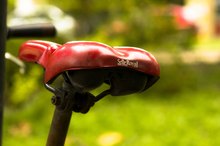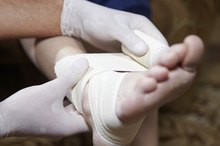What does fact checked mean?
At Healthfully, we strive to deliver objective content that is accurate and up-to-date. Our team periodically reviews articles in order to ensure content quality. The sources cited below consist of evidence from peer-reviewed journals, prominent medical organizations, academic associations, and government data.
- PubMed: Clinical Syndromes Associated with Bicycle Seats
- PubMed: Clinical Syndromes Associated with Bicycle Seats
The information contained on this site is for informational purposes only, and should not be used as a substitute for the advice of a professional health care provider. Please check with the appropriate physician regarding health questions and concerns. Although we strive to deliver accurate and up-to-date information, no guarantee to that effect is made.
Pelvic Pain & Bike Riding
Cycling can serve as a low-impact exercise outlet if you want to stay in shape. However, pelvic pain and pressure can sometimes limit you from going on lengthier rides or even riding comfortably. If you experience pelvic pain while cycling, you do not have to give up cycling entirely -- there are steps you can take to reduce painful symptoms.
If you are experiencing serious medical symptoms, seek emergency treatment immediately.
Compressed Nerve
Although mostly bony, your pelvis does have a nerve known as the pudendal nerve that sits on the pelvic floor. When you ride a bike, particularly for a long period of time, this nerve can become compressed, which can result in painful symptoms.
Cyclist's Syndrome
Bruised Tailbone From Cycling
Learn More
Pelvic pain following a bicycle ride is known as “Cyclists Syndrome.” This condition is characterized by genital numbness, aching in the pelvic region, urinary frequency or urgency, impotence and/or painful intercourse.
Make Adjustments
Finding the right bicycle fit can help to alleviate some of the pelvic pain that is associated with cycling 2. If you ride a road bike, ensure that you have enough distance between the saddle and handlebars. If you experience pelvic pain, try adjusting your saddle height in order to reduce pain. Also, check the leg extension -- if your leg is fully extended on your down-stroke and your hips do not rock while doing so, your seat is the right height. If not, adjust it to be taller or shorter.
- Finding the right bicycle fit can help to alleviate some of the pelvic pain that is associated with cycling 2.
- If you ride a road bike, ensure that you have enough distance between the saddle and handlebars.
Comfort Counts
Bicycle Seat & Nerve Damage
Learn More
In addition to fit considerations, it’s important to cycle on a comfortable bicycle seat. Even if your bicycle is a high-end model, you may not be cycling on the right type of seat for your pelvis. If you ride for speed, a narrower seat is more appropriate. Leisurely bicycle riders can consider a wider seat. Adding a suspension seat-post also may help to reduce the shock to the pelvis when riding over bumps.
- In addition to fit considerations, it’s important to cycle on a comfortable bicycle seat.
- Even if your bicycle is a high-end model, you may not be cycling on the right type of seat for your pelvis.
In some instances, pelvic pain while cycling is not because of a fit issue, but instead is the result of a biomechanical issue related to how you bike or your muscles 2. If adjustments to fit and saddle do not alleviate pain, consider seeing a physician for an evaluation.
Related Articles
References
- Jim Langley: Bike Saddles Explained
- The Feldenkrais Center: Cycling Pain
- PubMed: Clinical Syndromes Associated with Bicycle Seats
- Passavanti MB, Pota V, Sansone P, Aurilio C, De Nardis L, Pace MC. Chronic Pelvic Pain: Assessment, Evaluation, and Objectivation. Pain Res Treat. 2017;2017:9472925. doi:10.1155/2017/9472925
- Yunker A, Sathe NA, Reynolds WS, Likis FE, Andrews J. Systematic Review of Therapies for Noncyclic Chronic Pelvic Pain in Women. Obstetrical & Gynecological Survey. 2012;67(7):417-425. doi:10.1097/ogx.0b013e31825cecb3
- Smith CP. Male chronic pelvic pain: An update. Indian J Urol. 2016;32(1):34–39. doi:10.4103/0970-1591.173105
- Tu FF, Hellman KM, Backonja MM. Gynecologic management of neuropathic pain. Am J Obstet Gynecol. 2011;205(5):435–443. doi:10.1016/j.ajog.2011.05.011
- Choung RS, Herrick LM, Locke GR 3rd, Zinsmeister AR, Talley NJ. Irritable bowel syndrome and chronic pelvic pain: a population-based study. J Clin Gastroenterol. 2010;44(10):696–701. doi:10.1097/MCG.0b013e3181d7a368
- Barbieri, R., Patient education: Chronic pelvic pain in women (Beyond the Basics). UpToDate. Updated 08/18/16.
- Bharucha, A., and T. Lee. Aorectal and Pelvic Pain. Mayo Clinic Proceedings. 2016. 9(10):1471-1486.
- van Rijckevorsel, D., de Vries, M., Schreuder, L., Wilder-Smith, O., and H. van Goor. Risk Factors for Chronic Postsurgical Abdominal and Pelvic Pain. Pain Management. 201. 5(2):107-16.
Writer Bio
Rachel Nall began writing in 2003. She is a former managing editor for custom health publications, including physician journals. She has written for The Associated Press and "Jezebel," "Charleston," "Chatter" and "Reach" magazines. Nall is currently pursuing her Bachelor of Science in Nursing at the University of Tennessee.









